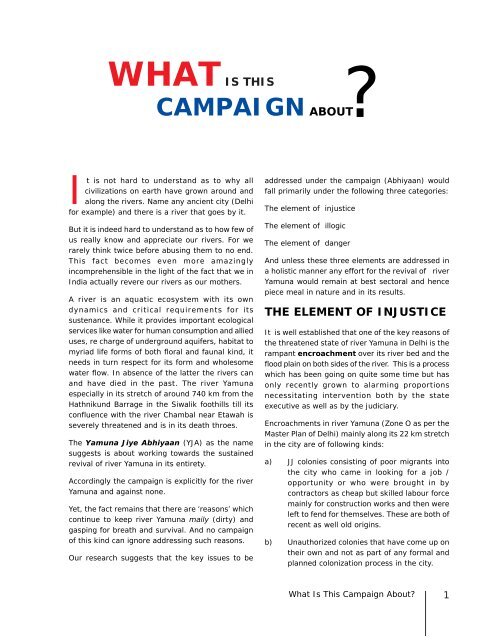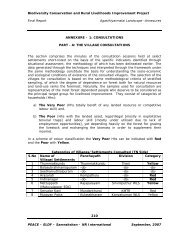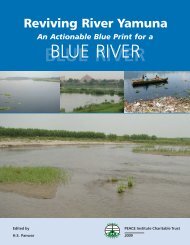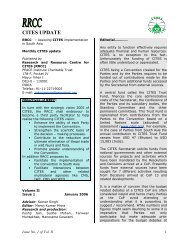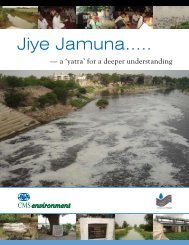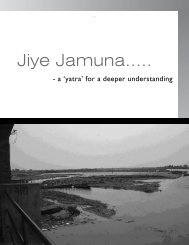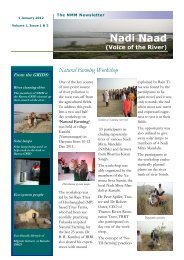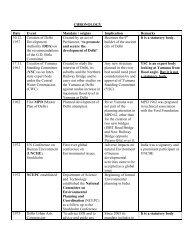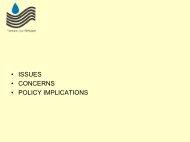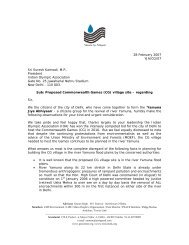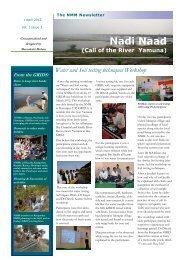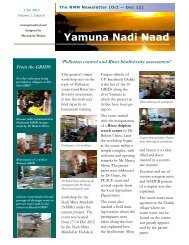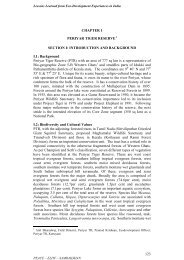What Is This Campaign About?
What Is This Campaign About?
What Is This Campaign About?
Create successful ePaper yourself
Turn your PDF publications into a flip-book with our unique Google optimized e-Paper software.
WHAT IS THIS<br />
CAMPAIGN ABOUT?<br />
It is not hard to understand as to why all<br />
civilizations on earth have grown around and<br />
along the rivers. Name any ancient city (Delhi<br />
for example) and there is a river that goes by it.<br />
But it is indeed hard to understand as to how few of<br />
us really know and appreciate our rivers. For we<br />
rarely think twice before abusing them to no end.<br />
<strong>This</strong> fact becomes even more amazingly<br />
incomprehensible in the light of the fact that we in<br />
India actually revere our rivers as our mothers.<br />
A river is an aquatic ecosystem with its own<br />
dynamics and critical requirements for its<br />
sustenance. While it provides important ecological<br />
services like water for human consumption and allied<br />
uses, re charge of underground aquifers, habitat to<br />
myriad life forms of both floral and faunal kind, it<br />
needs in turn respect for its form and wholesome<br />
water flow. In absence of the latter the rivers can<br />
and have died in the past. The river Yamuna<br />
especially in its stretch of around 740 km from the<br />
Hathnikund Barrage in the Siwalik foothills till its<br />
confluence with the river Chambal near Etawah is<br />
severely threatened and is in its death throes.<br />
The Yamuna Jiye Abhiyaan (YJA) as the name<br />
suggests is about working towards the sustained<br />
revival of river Yamuna in its entirety.<br />
Accordingly the campaign is explicitly for the river<br />
Yamuna and against none.<br />
Yet, the fact remains that there are ‘reasons’ which<br />
continue to keep river Yamuna maily (dirty) and<br />
gasping for breath and survival. And no campaign<br />
of this kind can ignore addressing such reasons.<br />
Our research suggests that the key issues to be<br />
addressed under the campaign (Abhiyaan) would<br />
fall primarily under the following three categories:<br />
The element of injustice<br />
The element of illogic<br />
The element of danger<br />
And unless these three elements are addressed in<br />
a holistic manner any effort for the revival of river<br />
Yamuna would remain at best sectoral and hence<br />
piece meal in nature and in its results.<br />
THE ELEMENT OF INJUSTICE<br />
It is well established that one of the key reasons of<br />
the threatened state of river Yamuna in Delhi is the<br />
rampant encroachment over its river bed and the<br />
flood plain on both sides of the river. <strong>This</strong> is a process<br />
which has been going on quite some time but has<br />
only recently grown to alarming proportions<br />
necessitating intervention both by the state<br />
executive as well as by the judiciary.<br />
Encroachments in river Yamuna (Zone O as per the<br />
Master Plan of Delhi) mainly along its 22 km stretch<br />
in the city are of following kinds:<br />
a) JJ colonies consisting of poor migrants into<br />
the city who came in looking for a job /<br />
opportunity or who were brought in by<br />
contractors as cheap but skilled labour force<br />
mainly for construction works and then were<br />
left to fend for themselves. These are both of<br />
recent as well old origins.<br />
b) Unauthorized colonies that have come up on<br />
their own and not as part of any formal and<br />
planned colonization process in the city.<br />
<strong>What</strong> <strong>Is</strong> <strong>This</strong> <strong>Campaign</strong> <strong>About</strong>?<br />
1
c) Structures created by the state in an ad hoc<br />
or planned manner.<br />
It is understood that an encroachment threatening<br />
an ecosystem is bad and is wrong irrespective of its<br />
origin, nature or legal status.<br />
Fortunately both the Supreme Court (SC) and the<br />
High Court of Delhi have been seized of this problem<br />
and have directed the state for taking action against<br />
encroachers from time to time ever since 1992 when<br />
an enlightened citizen of Delhi (Comdr Sureshwar<br />
D Sinha) first brought up the matter of the sad state<br />
of river Yamuna before the Hon SC.<br />
The worst irony and gross injustice happens when<br />
the lands which a re reportedly ‘recovered’ from<br />
During 2006 while JJ colonies in river flood plain between the<br />
Shahadara Bridge and the Nizamuddin Bridge were successfully<br />
relocated (under the supervision of the HC created Justice Usha<br />
Mehra Committee) similar encroachers both in Majnu Ka Tila and<br />
in areas south of DND managed to defy and remain. (one can see<br />
in this picture the Raj ghat Power plant in the back ground which<br />
itself is located in the flood plain)<br />
(Date of Photograph: 28 January 2007)<br />
Construction work going on (picture dated 28 January 2007) in<br />
the lands ‘freed’ from the Yamuna Pushta JJ colony ‘encroachers’<br />
in 2004.<br />
The third kind of injustice happens when the state<br />
in its own wisdom decides to permit either an<br />
Akshardham or a power plant or a Secretariat or a<br />
Metro depot to come up in the same river bed and<br />
flood plain creating thereby the so called ‘authorized’<br />
encroachments.<br />
the encroachers in the name of securing the river<br />
bed and reducing the pollution load from the river<br />
is later put to ‘developmental’ use/s by the same<br />
state.<br />
The other kind of injustice (as happened recently in<br />
2006) happens when as a result of a drive against<br />
encroachment only few get up-rooted and rest who<br />
can ‘influence’ or ‘manage’ remain.<br />
Google picture, showing the under construction, Shastri Park Metro<br />
Station in the river bed<br />
The JJ colonies seen diagonally opposite the metro station (under<br />
construction) in the south of the old railway bridge were removed<br />
and relocated in 2006<br />
2 <strong>What</strong> <strong>Is</strong> <strong>This</strong> <strong>Campaign</strong> <strong>About</strong>?
preventing the revival of river Yamuna. Even the<br />
judiciary while addressing the question of<br />
encroachments in the river has linked it only as a<br />
pollution issue rather than a issue about maintaining<br />
the integrity of the river ecosystem.<br />
While admittedly the rampant pollution of river<br />
Yamuna mainly in its 22 km stretch in Delhi is one<br />
of the major problems facing the river Yamuna it is<br />
firstly the question of the survival of the river as an<br />
ecosystem in its own right which should ideally take<br />
precedence over all other actions. If the river in its<br />
natural form is lost then clean water if ever available<br />
can as well flow in a channelised drain without the<br />
benefits accruing to the multitudes from a river<br />
system.<br />
Yamuna flood plain south of the ITO bridge under conversion<br />
for the Yamuna Depot of the Delhi Metro (Date of Photograph:<br />
28 January 2007)<br />
Focussing on an encroacher only as an existing or<br />
potential polluter automatically targets the residents<br />
of either the JJ colonies or of the unauthorized<br />
colonies since these remaining outside the planned<br />
sewage management schemes of the state are<br />
assumed to be the key polluters. <strong>This</strong> approach<br />
presumes that the river is not getting polluted either<br />
by the power plants, or the metro stations or an<br />
Akhshardham or a games village.<br />
PENNY WISE AND POUND FOOLISH<br />
Signature Bridge or the Najafgarh Drain<br />
The Najafgarh drain that meets the river Yamuna<br />
just down stream of the Wazirabad Barrage (see<br />
picture) is reputedly the most polluting of all the 22<br />
drains feeding the river in Delhi. (Date of<br />
Photograph: 28 January 200)<br />
There is a proposal to raise a games village for the 2010<br />
Commonwealth Games in Delhi spread over 42.5 ha of the Yamuna<br />
flood plain next to the structure called Akshardham.<br />
THE ELEMENT OF ILLOGIC<br />
MISSING THE WOODS FOR THE TREES<br />
Treating an encroacher only as a polluter is<br />
missing the larger picture<br />
The state and most others concerned has it seems<br />
till date diagnosed only pollution as the key ill<br />
<strong>What</strong> <strong>Is</strong> <strong>This</strong> <strong>Campaign</strong> <strong>About</strong>?<br />
3
There is a plan to construct a fancy bridge to be<br />
called as a Signature Bridge (see picture )at an<br />
estimated cost of around Rs 450 crores over almost<br />
exactly the place where the the infamous Najafgarh<br />
drain meets the river. (Date of Photograph: 28<br />
January 200)<br />
Now the irony is that while the government of India is seeking loan from the JBIC (Japan Bank for International Cooperation) to clean up<br />
the river Yamuna through activities to be implemented by the Government of Delhi, on the other the Government of Delhi has the luxury<br />
to plan for and erect a fancy bridge in the name of a future landmark (as if this ancient city of ours is short on landmarks to market it to<br />
tourists and others?) of the city.<br />
NB: If such money (at the tax payer’s cost) is indeed available then why can’t it be better<br />
utilized to clean up on a priority basis the very drain on which this bridge is proposed to come<br />
up?<br />
A BIRD IN HAND IS BETTER THAN THE TWO IN THE BUSH<br />
Augmentation of water availability in Delhi<br />
S.No. Source of Raw Water Name of the Plant Installed Capacity in 2021<br />
1 River Yamuna Chandrawal I & II 90 MGD<br />
2 River Yamuna Wazirabad I, II, & III 120 MGD<br />
3 Bhakra Storage Haiderpur I 100 MGD<br />
4 Yamuna Haidepur II 100 MGD<br />
5 Bhakra Storage Nangloi 40 MGD<br />
6 Upper Ganga Canal Bhagirathi 100 MGD<br />
7 Sub-Surface Water Ranney Wells/Tubewells 125 MGD<br />
8 Upper Ganga Canal Sonia Vihar 140 MGD<br />
9 Saving from seepage losses Dwarka 40 MGD<br />
with the constructionof new<br />
parallel lined channel<br />
10 Saving from seepage losses Bawana 20 MGD<br />
with the constructionof new<br />
parallel lined channel<br />
11 Saving from seepage losses Okhla 20 MGD<br />
with the constructionof new<br />
parallel lined channel<br />
12 Recycling of wastewater at water - 45 MGD<br />
treatment plants<br />
TOTAL<br />
940 MGD
Water supply scenario in 2021 (MPD 2021)<br />
Against the above scenario according to Delhi Jal<br />
Board (DJB) the projected demand in 2021 will be<br />
of 1380 MGD at the rate of 60 gpcd for 230 lakh<br />
population in Delhi.<br />
dependence on future dams and sources located<br />
outside the NCTD is being over emphasized.<br />
Clearly the Yamuna flood plain is a precious<br />
To meet this shortfall, according to the MPD-2021<br />
the work on following dams has to be expedited.<br />
There seems to be no other alternative (sic):<br />
(A)<br />
(B)<br />
(C)<br />
Renuka Dam on river Giri in Himachal Pradesh<br />
Kishau Dam on river Tons in Uttaranchal (now<br />
Uttarakhand)<br />
Lakhwar Vyasi Dam on river Yamuna in<br />
Uttaranchal (now Uttarakhand)<br />
According to the Central Ground Water Board<br />
the Yamuna flood plain in the north west, north<br />
east, east and the south districts have a ground<br />
water potential ranging from very large yield<br />
(100 – 280 cmt per hr) to large yield (50 – 100<br />
cmt per hr).<br />
According to a study published in 2004 by Dr P.<br />
Kumar of the Institute for Economic Growth Delhi,<br />
India:<br />
To maintain the ground water recharge potential<br />
of the floodplains, it is imperative to prevent<br />
any fresh civic structures to come up in these<br />
areas.<br />
Any human activity impairing the water recharge<br />
function of the floodplain ecosystem will create<br />
problems not only for the present but future<br />
generation too.<br />
Water recharge function of Yamuna Floodplain<br />
can not only save Rs 51-60 million per annum<br />
for the government of Delhi but it can<br />
substantially help in balancing the demandsupply<br />
gap in provisioning of water for Delhi.<br />
NB: In a scenario like above it is hard to fathom as<br />
to how the planners are over looking the vital<br />
importance and role of the Yamuna flood plain as<br />
the ground water recharge source in the city and<br />
not even talking about protecting this zone as critical<br />
part of the scheme of things in the MPD 2021 while<br />
resource to be zealously protected and NOT a<br />
waste land waiting to be ‘developed’. (Date of<br />
Photograph: 28 January 200)<br />
Say NO to Commonwealth Games 2010 village<br />
in the Yamuna flood plain<br />
Common man’s view of events like the<br />
Commonwealth Games<br />
- It is India and the city of Delhi in particular<br />
that has won the rights for holding the games<br />
from a competing country (Canada in this<br />
instance)<br />
- GOI is the organiser and hence the successful<br />
organisation of such an event is a national<br />
event involving national pride and prestige<br />
- GOI is within its right to spend money and<br />
invest its resources (including land) on such<br />
events<br />
The little appreciated FACTS are<br />
- It is the Indian Olympic Association (IOA)<br />
which is a non government registered<br />
<strong>What</strong> <strong>Is</strong> <strong>This</strong> <strong>Campaign</strong> <strong>About</strong>?<br />
5
Association (just like any other NGO) and<br />
NOT the Government of India (GOI) that bids<br />
for and is primarily responsible for the<br />
successful organisation of such events.<br />
- In other words (just like in Cricket, it is the<br />
Team - India and NOT the Indian team which<br />
is selected and managed by the BCCI) the<br />
Commonwealth Games is NOT an Indian<br />
event but an International games event bid<br />
successfully for being organised in Delhi in<br />
India by the IOA.<br />
- It is well known that the IOA’s last minute<br />
offer of USD 100,000 per member (72 in all)<br />
and the fact that the CG had never taken place<br />
before in India that clinched the bid in IOA’s<br />
favour.<br />
- GOI has reportedly agreed to underwrite all<br />
costs (difference between revenue and<br />
expenditure) for the organisation of the CG<br />
to the IOA.<br />
Lingering questions<br />
- How is the DDA (which is a GOI agency<br />
created by an Act of the Parliament) acting<br />
on behalf of IOA in raising the Games Village<br />
and the other infrastructure in Delhi?<br />
- When, who and how was the GOI enabled<br />
(by the Parliament?) to agree to underwrite<br />
all costs for the organizing of the CG to the<br />
IOA at the tax payer’s expensive?<br />
- How is the GOI accountable to the tax payer<br />
for such largesse?<br />
- Why does Delhi need another Games Village<br />
when a permanent Games Village already<br />
exists in the city (raised in Siri Fort area for<br />
the Asiad in 1982)?<br />
- If a new games village is needed now for the<br />
CG 2010 then would the same story be<br />
repeated the next time around too when<br />
another Games Village be sought to be raised<br />
in Delhi? (It is well known that IOA is bidding<br />
for the Asian Games 2014 to be held in Delhi!)<br />
- Why such events be held only in Delhi<br />
specially when the city is bursting at its seam<br />
in terms of growth and suffers from an acute<br />
shortage of land and woeful civic and other<br />
amenities? (In many other countries such<br />
games are organised in different cities)<br />
- <strong>Is</strong> the Commonwealth Games Federation<br />
(CGF) the parent body of the games aware<br />
that the proposed CG village is slated to be<br />
raised in a river flood plain with the potential<br />
to unleash a growth chain reaction which<br />
could disrupt the river ecosystem for ever?<br />
COMMONWEALTH GAMES 2010 –<br />
RESIDENTIAL PROJECT : SHORTLISTED<br />
APPLICANTS<br />
The following applicants have been shortlisted at<br />
the RFQ stage for invitation to participate in the<br />
RFP Process the Residential Project of the<br />
Commonwealth Games Village.<br />
1. M/S DLF Ltd<br />
2. M/S Omaxe Ltd<br />
3. M/S Nagarjuna Construction Co Ltd<br />
4. M/S Shapoorji Pallonji & Co Ltd<br />
5. M/S Larsen and Toubro Ltd<br />
6. M/S Parsavnath Developers Ltd<br />
7. M/S Ansal Properties and Infrastructure Ltd<br />
8. Consortium of CSCHK-Soma Enterprises<br />
9. Consortium of Namkwang-SPSL-PDI-CMCL<br />
10. Consortium led by Emaar PJSC<br />
11. Consortium of Unitech Ltd-IL&FS-PSDA-FCL<br />
ELEMENT OF DANGER<br />
DON’T EMBRACE CALAMITY<br />
Delhi is Flood Prone<br />
International<br />
Games<br />
COUNTRY YEAR GAMES CITY<br />
India 1951 Asian New Delhi<br />
1982 Asian New Delhi<br />
2010 Commonwealth New Delhi<br />
2014 (bid) Asian Games New Delhi<br />
Australia 1956 Olympics Melbourne<br />
1982 Commonwealth Brisbane<br />
2000 Olympics Sydney<br />
2006 Commonwealth Melbourne<br />
GB 1908 Olympics London<br />
1948 Olympics London<br />
COUNTRY YEAR GAMES CITY<br />
1970 Commonwealth Edinburgh<br />
1986 Commonwealth Edinburgh<br />
2002 Commonwealth Manchester<br />
US 1904 Olympics St Louis<br />
1932 Olympics Los Angeles<br />
1984 Olympics Los Angeles<br />
1996 Olympics Atlanta<br />
Korea 1986 Asian Seoul<br />
1988 Olympics Seoul<br />
2002 Asian Busan<br />
2014 (bid) Asian Incheon
Flood vulnerability (Source: Taranjot Kaur<br />
Gadhok, Senior Fellow, HSMI (HUSDCO), New Delhi)<br />
The city has been experiencing floods of various<br />
magnitudes in the past due to floods in the Yamuna<br />
and the Najafgarh Drain system. The Yamuna<br />
crossed its danger level (fixed at 204.83m) twenty<br />
five times during the last 33 years. Since 1900, Delhi<br />
has experienced six major floods in the years 1924,<br />
1947, 1976, 1978, 1988 and 1995 when peak level<br />
of Yamuna river was one meter or more above<br />
danger level of 204.49m at old rail bridge (2.66m<br />
above the danger level) occurred on 6 September<br />
1978. The second record peak of 206.92m was on<br />
27 September 1988.<br />
In the recent past, the city experienced high<br />
magnitude floods in 1977, 1978, 1988 and 1995,<br />
causing misery and loss of life and property to the<br />
residents of the city.<br />
Settlment pattern in flood plain<br />
A close analysis of the flood zoning pattern reveals<br />
that the high risk zones are the areas that have<br />
earlier been identified as unplanned or poorly<br />
planned areas having high population densities and<br />
sub standard housing structures. These include<br />
areas of North Delhi, and Trans Yamuna. Some<br />
of the colonies that have come up in these<br />
areas are at levels 3 to 4 meters below the<br />
1978 flood level.<br />
Risk of break in embankments<br />
Protection from the river by embankments lead<br />
to a false sense of safety and development<br />
starts taking place in the shadow of these<br />
embankments. In the event of failure of these<br />
protective works, as has been seen in the form of<br />
breaches during past floods, the effect is devastating<br />
because the pressure of the entire embanked<br />
stretch is released at one point, and it takes the<br />
people by surprise.<br />
European River (Thames or Seine) Model is No<br />
Panacea for River Yamuna<br />
Raw sewage floods River Thames<br />
(Source:www.smh.au/articles)<br />
August 6, 2004<br />
Environment authorities have mounted a major<br />
cleanup operation in London after Tuesday’s<br />
flooding forced hundreds of thousands of tonnes<br />
of raw sewage into the River Thames running<br />
through central London.<br />
The Environment Agency said 600,000 tonnes<br />
of untreated sewage overflowed into the river<br />
as London’s Victorian-era sewers were<br />
overwhelmed by torrential rains that brought<br />
chaos to parts of the city on Tuesday night.<br />
“The overflow has to go somewhere, and the<br />
Thames is the natural place,” a spokeswoman<br />
told Reuters on Wednesday.<br />
Flood scenario in Seine<br />
(Source: Pierre-Alain Roche, 2005)<br />
Studies conducted in the 1990s gave the authorities<br />
an initial warning by estimating the damage from a<br />
flood comparable to that of 1910 at 4.6 billion euros<br />
(1990 scenario). These same studies also estimated<br />
that the disruption caused by a rise in the level of<br />
the Seine equal to that reached during the 1910<br />
flood would affect:<br />
· 70% of metro traffic for 30 to 50 days;<br />
· 50% of RER traffic for 30 to 50 days;<br />
· over 200 000 electricity subscribers;<br />
· over 1 million telephone subscribers;<br />
· around 100 000 gas subscribers;<br />
· 5 household waste processing plants;<br />
· 5 district heating plants;<br />
· 50% of drinking water supplies.<br />
The most recent estimates have raised this figure<br />
to 12 billion euros. The reason for this increase is<br />
that in addition to direct damage there are also the<br />
costs resulting from the loss or disruption of a large<br />
number of public services. The failure of an EDF<br />
transformer affects a much larger area than the area<br />
actually flooded; the same is true of all utility<br />
networks (telecommunications, district heating,<br />
drinking water, drains and sewers, etc. and<br />
obviously, transport networks too ). Like a house<br />
<strong>What</strong> <strong>Is</strong> <strong>This</strong> <strong>Campaign</strong> <strong>About</strong>?<br />
7
of cards collapsing, knock-on effects would spread<br />
the impacts of the flooding to areas far removed<br />
from those actually under water; the estimated costs<br />
of “indirect” damage constantly rise the more they<br />
are studied in greater detail.<br />
Worst Case Scenario in Delhi (25 yrs floods)<br />
(fictional but possible)<br />
It is 20 th July 201…It has been raining incessantly<br />
for the last two days in Delhi. In the hills the rain<br />
had been unusually severe this monsoon.<br />
Unknown to most residents in Delhi, the waters in<br />
river Yamuna have been rising steadily over the last<br />
few days but since this morning the rise had taken<br />
menacing proportions and the authorities in the<br />
railways and the Delhi Metro have started to take<br />
precautionary measures for maintaining the<br />
services. The metereological forecast has at best<br />
been tentative but a storm accompanied by heavy<br />
rains in and around Delhi has been forecasted.<br />
By about 0900 hrs the authorities at the Hathnikund<br />
Barrage in Haryana have informed all concerned that<br />
they can hold no longer and for the safety of the<br />
Barrage large amount of water would have to be<br />
released immediately into the main Yamuna river.<br />
By 1800 hrs the rising Yamuna waters in Delhi have<br />
resulted in sluices in the Wazirabad Barrage as well<br />
as the Yamuna and the Okhla Barrage to be opened<br />
in full. Surging Yamuna waters have breached all<br />
the minor embankments and spread all over its<br />
whatever remaining flood plains. Flood waters have<br />
entered the Sonia Vihar areas in East Delhi including<br />
the CRPF camp and the DJB water works colony.<br />
The unfinished Signature Bridge is tantalizingly<br />
perched over the torrential waters. The Yamuna<br />
Pushta embankment is about to be breached. All<br />
Metro operations to and from the Shastri Park and<br />
the Yamuna station have been brought to a complete<br />
halt. Waters have entered the Akshardham temple<br />
and emergency evacuation of men and material from<br />
there has been taken up on war footing. The<br />
residents in the CG village apartments and the<br />
shopping centre have been advised to move to safer<br />
places. With fading lights due to torrential rains the<br />
evacuation is proving to be difficult since the electric<br />
supply all over east Delhi has been put off as an<br />
emergency precautionary measure.<br />
By 1900 hrs the Yamuna waters have started to<br />
over top the Yamuna Pushta bund near Geeta Colony<br />
and the water has started to enter low lying areas<br />
in trans Yamuna localities of Geeta Colony and Laxmi<br />
Nagar. There is chaos all over with people in large<br />
numbers moving towards safer areas in Ghaziabad<br />
and beyond. The bridge over the Hindon in<br />
Ghaziabad is chocked with slow moving cars since<br />
the Hindon itself is in spate.<br />
By 2100 hrs the waters have started to threaten<br />
the Yamuna pushta embankment on the east bank<br />
of the river and the authorities are forced to create<br />
a breach to safeguard the embankment which<br />
immediately starts to flood the low lying areas in<br />
trans Yamuna areas even beyond the already<br />
submerged Geeta colony and Shastri Park. Water<br />
by now is all over the Shastri park Metro head<br />
quarters and the Metro operations have all but been<br />
brought to a stand still all over the city. All the<br />
bridges over the river have been declared unsafe<br />
with only the DND still operable. There is a real<br />
possibility that the trans Yamuna area might be cut<br />
off from the rest of the city.<br />
Similarly in the western bank of the river, flood<br />
waters have started to enter Model town and<br />
Mukherji Nagar mainly through the drains which are<br />
now flowing in reverse directions carrying as much<br />
the flood waters as the filth of the drains. Flood<br />
waters have spread all over the Samadhis and<br />
reached the ground floor of the Delhi Secretariat as<br />
also brought to a halt normal operations in all the<br />
power stations located in the west bank of the river.<br />
There is a sense of major catastrophe having<br />
engulfed Delhi something akin to that happened in<br />
Mumbai in the year 2005.<br />
The Prime Minister is in emergency meeting with<br />
all the concerned officials of both the centre and<br />
the Delhi administration including the Chief Minister<br />
and the Lt Governor of Delhi and an urgent action<br />
plan is being put into place to effectively monitor<br />
the situation and to provide immediate relief and<br />
succour to the affected. A flood monitoring control<br />
room is set up in the PMO with the disaster<br />
management group trying to come to grips and<br />
control of the situation.<br />
8 <strong>What</strong> <strong>Is</strong> <strong>This</strong> <strong>Campaign</strong> <strong>About</strong>?
The dawn of July 21 is of little respite. Torrential<br />
rains all over north India continue to play havoc not<br />
just in Delhi with news of devastating floods from<br />
all over north and east India continuing to pour in.<br />
There has been a massive evacuation of people from<br />
affected areas in east Delhi with no immediate<br />
reliable information available about the extent of<br />
loss of life or property in that part of the city. There<br />
is no power available in most parts of the city which<br />
in turn has affected the supply of drinking water to<br />
large areas. All schools and colleges in the city have<br />
been closed down for a week. Attendance in offices<br />
has nose-dived. Rumours have started to run rife<br />
with human causalities figure reportedly rising by<br />
the hour. Media especially the TV continues to<br />
provide round the clock live coverage of the<br />
unprecedented flooding in the city. The situation<br />
changes little for another three days.<br />
It is only after 3 days of unrelenting mayhem from<br />
the flood waters that some semblance of respite is<br />
finally in place although occasional showers still<br />
abound. Affected people start to return to their<br />
homes to retrieve whatever is left untouched by<br />
the flood waters. It is not another week before<br />
skeleton Metro services are put back in operation.<br />
Gaping holes greet a commuter on the roads and<br />
the railways which had ceased operation for almost<br />
two days begin to operate again. The human<br />
casuality figure from the floods are reported to be<br />
in hundreds and the loss to property is topping<br />
thousands of crores of rupees.<br />
Soon reports of water borne diseases spreading<br />
across the city and in nearby suburbs occupy<br />
headlines with the administration coming under<br />
severe scrutiny for its apparent lack of preparedness<br />
and foresight.<br />
A high level enquiry committee after a painstaking<br />
deliberation of over six months reports that the<br />
major reason for the high devastation caused by<br />
the floods was lack of adequate flood plains<br />
remaining in the city with major chunks of it having<br />
been diverted over the years to alternate uses.<br />
Safety estimates about the embankments in the<br />
Yamuna flood plains were all found to be on<br />
unrealistically higher side and hence it was a wrong<br />
decision to permit development of the river flood<br />
plain including the permission granted to the DMRC,<br />
Akshardham, CG village and various other big and<br />
small structures, built in the flood plain. The<br />
committee has recommended immediate review of<br />
the presence of ALL structures standing in the river<br />
flood plain with an option to demolish or phase out<br />
all of them to allow the river flood plain to revert<br />
back to its natural self.<br />
NB: Clearly the Yamuna flood plains need to be<br />
declared inviolate and sacrosanct if for no other<br />
reason than its flood time critical role.<br />
Delhi is Vulnerable to Damage from<br />
Earthquake<br />
According to RN Iyengar (quoted in<br />
GISdevelopment.net)<br />
Delhi, which lies in Seismatic Zone IV, is currently<br />
experiencing mild seismicity. An earthquake of<br />
magnitude 7.0 on the Richter scale, that was once<br />
considered hypothetical, is today a very real<br />
possibility. Keeping in view the forecast of a major<br />
earthquake resistant design consideration, it has<br />
become imperative to size up the earthquake<br />
scenario of the city and increase awareness of<br />
earthquake resistant techniques.<br />
Considering areas affected during past earthquakes<br />
of M - 6.5, it can be expected that such an<br />
earthquake occurring in Delhi could adversly affect<br />
the whole of it with damaging intensities and more<br />
than 50% of the Delhi Metropolitan Area - in terms<br />
of probable damage scenario, earthquake would be<br />
the worst natural disaster for Delhi.<br />
An issue of concern to development managers and<br />
citizens of the city today is that many groups of<br />
Indian and American scientists have forecast a major<br />
seismic upheaval of a probable magnitude 9 on the<br />
Richter scale in North India. The forecast is based<br />
on a detailed study of past Indian earthquakes and<br />
analysis of plate tectonics of the region.<br />
NB: It is well known that within Delhi it is the<br />
Yamuna flood plain area like the recently<br />
developed area of trans - Yamuna which is most<br />
vulnerable to damage from an earth quake. It<br />
is more the reason why no new structure should<br />
be constructed in the remaining Yamuna flood<br />
plain area.<br />
<strong>What</strong> <strong>Is</strong> <strong>This</strong> <strong>Campaign</strong> <strong>About</strong>?<br />
9
WHAT CAN AND<br />
SHOULD BE DONE?<br />
IMMEDIATE MEASURE<br />
- MOEF to notify a River zone Regulation under<br />
the EPA 1986 on the lines of the CRZ<br />
notification<br />
- Delhi government to enact a law for protection<br />
of the river Yamuna flood plain (Zone O in<br />
Delhi) against any unlawful activity including<br />
encroachment (of any kind), pollution and<br />
unauthorized drawal of ground water<br />
- An ordinance declares the constitution of a<br />
ground water reservoir sanctuary in the Zone<br />
O (river Yamuna) in Delhi<br />
- MOUD to accordingly revise the MPD 2021 to<br />
ensure that the Zone O is made inviolate as<br />
recommended both by the MPD 1962 and<br />
1982<br />
- MOEF to move the Hon. SC to seek full<br />
implementation of the water sharing MOU<br />
between the states of UA, HP, UP, Haryana<br />
and Delhi to ensure the minimum flow in the<br />
river Yamuna<br />
- The proposed site of the CG 2010 village is<br />
immediately changed so that no time is lost<br />
in making requisite preparations for the<br />
organization of the said games.<br />
- Similarly any work on the proposed Signature<br />
Bridge is stopped till its feasibility and<br />
desirability is fully established<br />
- All other ongoing earth works (including the<br />
so called Global Village) in river Yamuna are<br />
put on a hold till an environmental review<br />
has been conducted by an independent panel<br />
SHORT TERM MEASURE<br />
- A citizen’s white paper on river Yamuna is<br />
prepared and presented to the nation’s<br />
Parliament through the people’s<br />
representatives<br />
- A thorough professional and transparent<br />
review of YAP is carried out in a time bound<br />
measure and till then all plans to clean the<br />
Yamuna including the so called Thames model<br />
plan is put on a hold<br />
- Delhi government promulgates a rain water<br />
harvest law to ensure that it becomes a<br />
practice enforceable by law<br />
- All existing encroachment in the river bed and<br />
flood plains (both by the state and by private<br />
agencies / individuals) be reviewed and<br />
recommended by a independent panel<br />
consisting of experts and concerned civil<br />
society representatives including the<br />
representatives of the RWAs<br />
- The nation’s parliament and the states<br />
consider the advisability of including the rivers<br />
and the water in to the concurrent list of the<br />
Constitution so that a national law on the vital<br />
issue is possible to enact and implement<br />
- A notification under EPA empowers the MOEF<br />
to get periodical EIAs (post construction)<br />
carried out of all such structures and<br />
constructions which have a potential to either<br />
pollute or endanger the safety of natural<br />
systems like rivers and lakes.<br />
10 <strong>What</strong> <strong>Is</strong> <strong>This</strong> <strong>Campaign</strong> <strong>About</strong>?
LONG TERM MEASURE<br />
- A people’s movement all along the length of<br />
the river (Delhi, Mathura and Agra in<br />
particular) takes up the task of the cleaning<br />
of the river Yamuna with a missionary zeal<br />
- Rain water harvesting becomes a well<br />
accepted norm in the country<br />
- A regulated drawal limited to an annual<br />
recharge estimates from the Ground water<br />
reservoir Sanctuary (Zone O) in Delhi meets<br />
most of the water shortfall in the city<br />
- The proposed dams on the key tributaries of<br />
the river Yamuna are taken up to augment<br />
dry season flow in the river<br />
- The WYC and EYC are repaired to plug<br />
transport losses<br />
- Proposed Satluj- Yamuna link and Sharda –<br />
Yamuna link are established<br />
<strong>What</strong> <strong>Is</strong> <strong>This</strong> <strong>Campaign</strong> <strong>About</strong>?<br />
11


